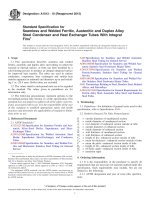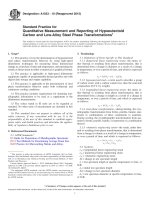Astm d 1901 10 (2015)
Bạn đang xem bản rút gọn của tài liệu. Xem và tải ngay bản đầy đủ của tài liệu tại đây (64.96 KB, 2 trang )
Designation: D1901 − 10 (Reapproved 2015)
Standard Test Method for
Relative Evaporation Time of Halogenated Organic Solvents
and Their Admixtures1
This standard is issued under the fixed designation D1901; the number immediately following the designation indicates the year of
original adoption or, in the case of revision, the year of last revision. A number in parentheses indicates the year of last reapproval. A
superscript epsilon (´) indicates an editorial change since the last revision or reapproval.
This standard has been approved for use by agencies of the U.S. Department of Defense.
1. Scope
5. Significance and Use
1.1 This test method covers the measurement of the relative
evaporation time of halogenated organic solvents and their
admixtures. This test method is not applicable in the presence
of excessive drafts or high-velocity air currents.
5.1 This test method gives valid comparisons of the evaporation rates of the subject materials. These comparisons are
required for the determination of the suitability of a proposed
material for specific cleaning applications.
1.2 The values stated in SI units are to be regarded as
standard. No other units of measurement are included in this
standard.
1.3 This standard does not purport to address all of the
safety concerns, if any, associated with its use. It is the
responsibility of the user of this standard to establish appropriate safety and health practices and determine the applicability of regulatory limitations prior to use.
6. Apparatus
6.1 Test Panel—A 1 by 100 by 150-mm panel of aluminum,
AA Alloy 6061,3 Temper T4 or T6, having a horizontal scribe
mark across the width of the panel 25 mm from one 100-mm
edge.
6.2 Support Base to hold the panel at 60 6 1° from the
horizontal.
6.3 Stopwatch, or electric interval timer.
2. Referenced Documents
6.4 Graduate, 10-mL, with pouring lip.
2.1 ASTM Standards:2
B209 Specification for Aluminum and Aluminum-Alloy
Sheet and Plate
7. Reagents
7.1 Perchloroethylene, initial boiling point 121°C, boiling
range 2°C, purity 99 %.
3. Terminology
7.2 p-Xylene, 99 %.
3.1 Definitions:
3.1.1 admixture—a blend of a halogenated hydrocarbon
with a nonhalogenated hydrocarbon (for example, mineral
spirits).
8. Procedure
8.1 Place a clean, water-break-free test panel on the support
base at an angle of 60 6 1° from the horizontal, with the scribe
mark at the lower end of the panel (Note 1). Using the
graduate, pour 10 mL of the material under test over the test
panel, being sure to get complete coverage of the entire
exposed surface. As soon as the 10 mL of test material has been
poured, observe the upper edge of the panel for a break in the
continuity of coverage. Start the timing at the first sign of a
break in liquid film coverage on the upper edge of the panel.
Stop the timing when the last portion of film has receded below
the scribe mark (Note 2). This interval between the first sign of
incomplete coverage and the receding of the last portion of film
below the scribe mark is referred to as the “dry time.”
4. Summary of Test Method
4.1 The evaporation rate is determined by measuring the
time required for complete evaporation of a thin film of the
solvent from a sheet-metal panel in comparison with a reference standard solvent.
1
This test method is under the jurisdiction of ASTM Committee D26 on
Halogenated Organic Solvents and Fire Extinguishing Agents and is the direct
responsibility of Subcommittee D26.04 on Test Methods.
Current edition approved June 1, 2015. Published June 2015. Originally
approved in 1961 as D1901 – 61 T. Last previous edition approved in 2010 as
D1901-10. DOI: 10.1520/D1901-10R15.
2
For referenced ASTM standards, visit the ASTM website, www.astm.org, or
contact ASTM Customer Service at For Annual Book of ASTM
Standards volume information, refer to the standard’s Document Summary page on
the ASTM website.
3
Aluminum Association alloy designation in accordance with ASTM Specification B209, for Aluminum-Alloy Sheet and Plate, Annual Book of ASTM Standards,
Vol 02.02.
Copyright © ASTM International, 100 Barr Harbor Drive, PO Box C700, West Conshohocken, PA 19428-2959. United States
1
D1901 − 10 (2015)
NOTE 1—By placing a double thickness of paper toweling under the test
panel and support base, solvent runoff from the panel is absorbed. The use
of fresh paper toweling after each individual test prevents saturation of the
test area with solvent vapors and gives more reproducible results.
NOTE 2—Stray intermittent drafts must be avoided during the timing
interval if reproducible results are to be obtained. Slight, steady air motion
will not appreciably affect results. The operator must avoid exposure to
excessive concentrations of the test solvent.
Relative evaporation time versus reference solvent
5
(1)
dry time of test material
dry time of reference solvent
10. Precision and Bias
10.1 Repeatability—Duplicate results by the same operator
should not be considered suspect unless they differ by more
than 64%.
8.2 Run the test in triplicate, with alternate runs of the
material under test and the referenced standard solvent (pxylene or perchloroethylene). The choice of reference solvent
shall be subject to agreement between the purchaser and the
seller, but the results reported shall indicate which one was
used.
10.2 Reproducibility—The result submitted by each of two
laboratories should not be considered suspect unless the two
results differ by more than 65%.
NOTE 4—The significance of this test method is not lessened by a lack
of extreme precision.
NOTE 3—By running the test material against a reference standard, and
thereby making the results a measure of relative evaporation time, the
influences of changes in temperature, relative humidity, and slight drafts
are minimized.
10.3 Bias—The bias for this test method has not yet been
determined due to a lack of known standards.
9. Calculation
11. Keywords
9.1 Calculate the relative evaporation time of the test
material as follows:
11.1 evaporation time; relative evaporation time; waterbreak test
ASTM International takes no position respecting the validity of any patent rights asserted in connection with any item mentioned
in this standard. Users of this standard are expressly advised that determination of the validity of any such patent rights, and the risk
of infringement of such rights, are entirely their own responsibility.
This standard is subject to revision at any time by the responsible technical committee and must be reviewed every five years and
if not revised, either reapproved or withdrawn. Your comments are invited either for revision of this standard or for additional standards
and should be addressed to ASTM International Headquarters. Your comments will receive careful consideration at a meeting of the
responsible technical committee, which you may attend. If you feel that your comments have not received a fair hearing you should
make your views known to the ASTM Committee on Standards, at the address shown below.
This standard is copyrighted by ASTM International, 100 Barr Harbor Drive, PO Box C700, West Conshohocken, PA 19428-2959,
United States. Individual reprints (single or multiple copies) of this standard may be obtained by contacting ASTM at the above
address or at 610-832-9585 (phone), 610-832-9555 (fax), or (e-mail); or through the ASTM website
(www.astm.org). Permission rights to photocopy the standard may also be secured from the Copyright Clearance Center, 222
Rosewood Drive, Danvers, MA 01923, Tel: (978) 646-2600; />
2









